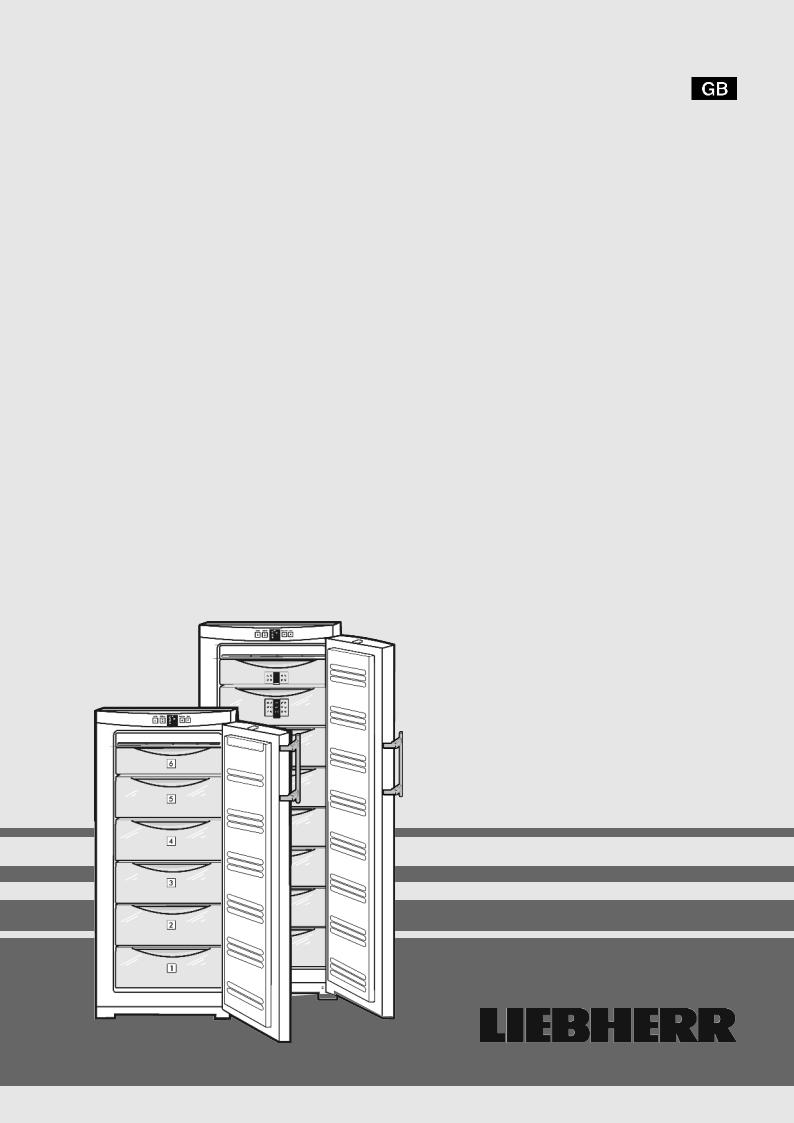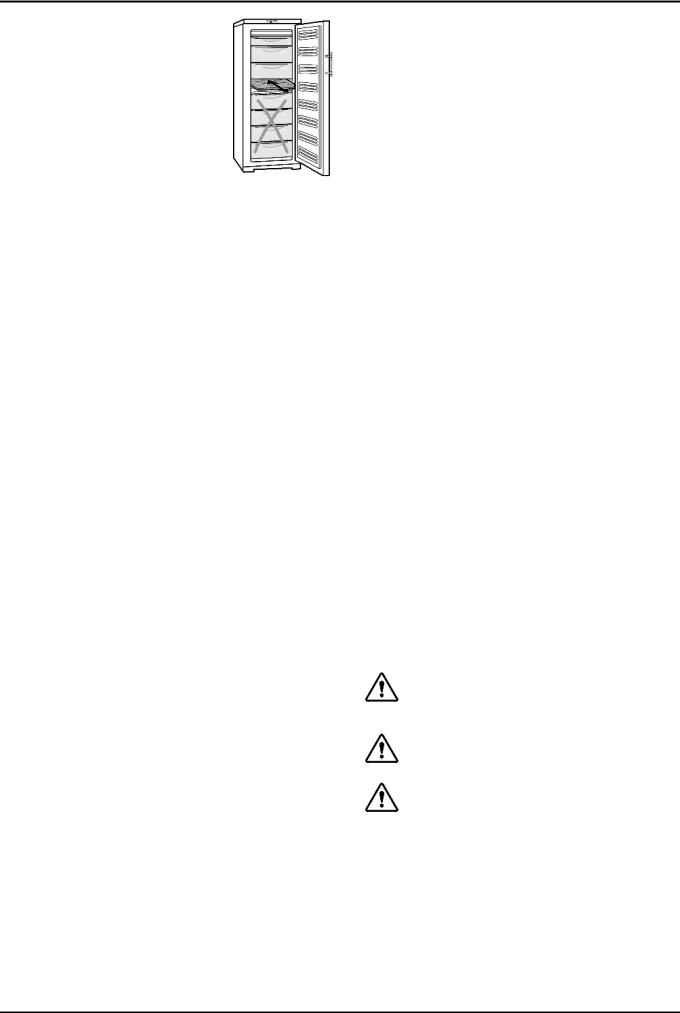Liebherr GNP 2713, GNP 3013 Manual

Operating instructions
Freezer
131212 7085598 - 00
GN ... 3

Appliance at a glance
Contents |
|
1 Appliance at a glance |
|||
1 |
Appliance at a glance............................................ |
2 |
1.1 Description of appliance and equip- |
||
1.1 |
Description of appliance and equipment.................. |
2 |
|||
1.3 |
Conformity................................................................ |
3 |
ment |
||
1.2 |
Range of appliance use............................................ |
2 |
|
|
|
1.4 |
External dimensions of the appliance....................... |
3 |
|
|
|
Note |
|||||
1.5 |
Saving energy |
3 |
|||
u Shelves, drawers and baskets are arranged for optimum |
|||||
1.6 |
Insulation plate......................................................... |
3 |
|
energy efficiency on delivery. |
|
2 |
General safety information................................... |
4 |
|
||
|
|
||||
3 |
Controls and displays........................................... |
5 |
|
|
|
3.1 |
Operating and control elements............................... |
5 |
|
|
|
3.2 |
Temperature display................................................. |
5 |
|
|
|
4 |
Putting into operation............................................ |
5 |
|
|
|
4.1 |
Transporting the appliance....................................... |
5 |
|
|
|
4.2 |
Installing the appliance............................................. |
5 |
|
|
|
4.3 |
Changing over the door hinges................................ |
6 |
|
|
|
4.4 |
Insertion into a row of kitchen units........................... |
7 |
|
|
|
4.5 |
Disposing of packaging............................................ |
7 |
|
|
|
4.6 |
Connecting the appliance......................................... |
8 |
|
|
|
4.7 |
Switching on the appliance....................................... |
8 |
|
|
|
5 |
Control.................................................................... |
8 |
|
|
|
5.1 |
Brightness of the temperature display...................... |
8 |
|
|
|
5.2 |
Child proofing........................................................... |
8 |
|
|
|
5.3 |
Door alarm................................................................ |
9 |
|
|
|
5.4 |
Temperature alarm................................................... |
9 |
|
|
|
5.5 |
Freezing food........................................................... |
9 |
|
|
|
5.6 |
Thawing food............................................................ |
9 |
|
|
|
5.7 |
Setting the temperature............................................ |
9 |
|
|
|
5.8 |
SuperFrost............................................................... |
9 |
|
|
|
5.9 |
Drawers.................................................................... |
10 |
|
|
|
5.10 |
Shelves.................................................................... |
10 |
|
|
|
5.11 |
VarioSpace............................................................... |
10 |
|
|
|
5.12 |
Information system................................................... |
10 |
|
|
|
5.13 |
Drawer for herbs and berries.................................... |
10 |
|
|
|
5.14 |
Cold storage accumulators....................................... |
10 |
|
|
|
6 |
Maintenance........................................................... |
10 |
|
|
|
6.1 |
Defrosting with NoFrost............................................ |
10 |
|
|
|
6.2 |
Cleaning the appliance............................................. |
10 |
|
|
|
6.3 |
Customer service..................................................... |
11 |
|
|
|
7 |
Malfunction............................................................. |
11 |
|
|
|
8 |
Decommissioning.................................................. |
11 |
8.1 |
Switching off the appliance....................................... |
11 |
8.2 |
Taking the appliance out of service.......................... |
12 |
9 |
Disposing of the appliance................................... |
12 |
The manufacturer works constantly on the further development of all the types and models. Therefore please understand that we have to reserve the right to make design, equipment and technical modifications.
To get to know all the benefits of your new appliance, please read the information contained in these instructions carefully.
The instructions apply to several models. Differences may occur. Text relating only to specific appliances is marked with an asterisk (*).
Instructions for action are marked with a  , the results of action are marked with a
, the results of action are marked with a  .
.
(1) |
Transport grips at back |
(6) |
Fig. 1 |
Type plate |
|||
(2) |
Operating and control |
(7) |
Drawers |
(3) |
elements |
(8) |
Information system* |
NoFrost |
|||
(4) |
Herb and berry tray |
(9) |
VarioSpace |
(5) |
Cold storage accumu- |
(10) Height-adjustable feet, |
|
|
lator* |
|
transport grips at front, |
|
|
|
transport castors at back |
1.2 Range of appliance use
The appliance is suitable solely for cooling food in a domestic environment or similar. This includes use in, for example
-in staff kitchenettes, bed and breakfast establishments,
-by guests in country homes, hotels, motels and other forms of accommodation,
-in catering and similar services in the wholesale trade
2

Appliance at a glance
Use the appliance solely as is customary within a domestic environment. All other types of use are inadmissible. The appliance is not suitable for storing and cooling medicines, blood plasma, laboratory preparations or similar substances and products covered by the 2007/47/EC Medical Devices Directive. Misuse of the appliance can result in the stored products suffering harm or perishing. Furthermore, the appliance is not suitable for operation in potentially explosive atmospheres.
The appliance is set to operate within specific ambient temperature limits according to its climate rating. The correct climate rating for your appliance is indicated on the type plate.
Note
uCompliance with the ambient temperatures indicated is required, otherwise the cooling performance is reduced.
Climate |
for ambient temperatures |
rating |
|
SN, N |
up to 32 °C |
ST |
up to 38 °C |
T |
up to 43 °C |
The appliance will function properly in ambient temperatures of down to 5 °C.
1.3 Conformity
The refrigerant circuit is tested for leakage. The appliance complies with the relevant safety regulations and EC Directives 2006/95/EC, 2004/108/EC, 2009/125/EC and 2010/30/EU.
Note for test institutions:
Tests are to be carried out according to the applicable standards and guidelines.
Preparation and testing of the appliances must be carried out taking the manufacturer's loading plans and the notes in the operating manual into account.
1.4 External dimensions of the appliance
|
Fig. 2 |
|
|
Model |
Height of appliance H (mm) |
GN/GNP 19.. |
1250 |
GN/GNP 23.. |
1447 |
GN/GNP 27.. |
1644 |
GN/GNP 30.. |
1841 |
x For appliances supplied with wall spacers, the measurement increases by 35 mm (see 4.2) .
1.5Saving energy
-Always ensure good ventilation. Do not cover ventilation openings or grille.
-Do not place appliance in areas of direct sunlight or next to a stove, heater or similar object.
-The energy consumption depends on the installation conditions, e.g. the ambient temperature (see 1.2) .
-Keep the time the appliance is open to a minimum.
-The lower the temperature setting, the higher the power consumption.
-Store food logically. (see Appliance at a glance).
-Ensure that all food is well packed and covered for storage. This will prevent frost from forming.
-First cool warm food to room temperature before storing it .
Accumulated dust increases the energy consumption:
-Once a year, dust the refrigerating unit together with the metal grille of the heat exchanger at the back of the appliance.
1.6 Insulation plate
The insulation plate for part-load operation is available as an accessory from specialist dealers.
3

General safety information
If you do not store much food in the appliance, you can reduce the power consumption by as much as 50 % by using the insulation plate. Up to 5 drawers can be deenergised, depending on model. At least 3 drawers are necessary for cooling. More information accompanies the insulation plate.
2 General safety information
Danger for the user:
-This appliance can be used by children of 8 years old and over, and also by persons with restricted physical, sensory or mental capacity or lack of experience and knowledge, if they are supervised or have been instructed on safe use of the appliance and understand the resulting risks. Children must not be allowed to play with the appliance. Cleaning and user maintenance must not be carried out by children without supervision.
-When disconnecting the appliance from the supply, always take hold of the plug. Do not pull the cable.
-In the event of a fault pull out the mains plug or deactivate the fuse.
-Do not damage the mains power cable. Do not operate the appliance with a defective mains power cable.
-Have any repairs to or intervention in the appliance, and any change of the mains power cable, carried out by the customer service only or by other specialised personnel trained for the purpose.
-Only assemble, connect and dispose of the appliance according to the instructions.
-Please keep these instructions in a safe place and pass them on to any subsequent owners.
Fire hazard:
-The refrigerant R 600a is environmentally friendly but flammable. Escaping refrigerant may ignite.
•Do not damage the refrigerant circuit pipes.
•Do not allow naked flames or ignition sources to enter the appliance.
•Do not use any electrical appliances in the interior (e.g. steam cleaners, heaters, ice cream maker etc.).
•If refrigerant escapes: remove any naked flames or sources of ignition from the leakage area. Ventilate the room well. Notify the after-sales service.
-Do not store explosives or sprays using combustible propellants such as butane, propane, pentane, etc. in the appliance. To identify these spray cans, look for the list of contents printed on the can, or a flame symbol. Gases possibly escaping may ignite due to electrical components.
-Keep burning candles, lamps and other items with naked flames away from the appliance so that they do not set the appliance on fire.
-Please be sure to store alcoholic drinks or other packaging containing alcohol in tightly closed containers. Any alcohol that leaks out may be ignited by electrical components.
Danger of tipping and falling:
-Do not misuse the plinth, drawers, doors etc. as a step or for support. This applies particularly to children.
Danger of food poisoning:
-Do not consume food which has been stored too long.
Danger of frostbite, numbness and pain:
-Avoid lasting skin contact with cold surfaces or refrigerated/frozen food or take protective steps, e.g. wear gloves. Do not consume ice cream, water ice or ice cubes immediately and do not consume them too cold.
Danger of injury and damage:
-Hot steam can lead to injury. Do not use electrical heating or steam cleaning equipment, open flames or defrosting sprays to defrost.
-Do not use sharp implements to remove the ice.
Please observe the specific information in the other sections:
|
DANGER |
identifies a situation involving direct |
|
|
danger which, if not obviated, may |
|
|
result in death or severe bodily |
|
|
injury. |
|
WARNING |
identifies a dangerous situation |
|
|
which, if not obviated, may result in |
|
|
death or severe bodily injury. |
|
CAUTION |
identifies a dangerous situation |
|
|
which, if not obviated, may result in |
|
|
minor or medium bodily injury. |
|
NOTICE |
identifies a dangerous situation |
|
|
which, if not obviated, may result in |
|
|
damage to property. |
|
|
|
|
Note |
identifies useful information and tips. |
4
